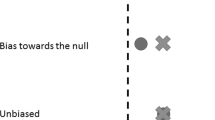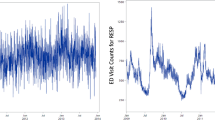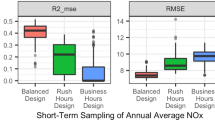Abstract
In this study, we investigated bias caused by spatial variability and spatial heterogeneity in outdoor air-pollutant concentrations, instrument imprecision, and choice of daily pollutant metric on risk ratio (RR) estimates obtained from a Poisson time-series analysis. Daily concentrations for 12 pollutants were simulated for Atlanta, Georgia, at 5 km resolution during a 6-year period. Viewing these as being representative of the true concentrations, a population-level pollutant health effect (RR) was specified, and daily counts of health events were simulated. Error representative of instrument imprecision was added to the simulated concentrations at the locations of fixed site monitors in Atlanta, and these mismeasured values were combined to create three different city-wide daily metrics (central monitor, unweighted average, and population-weighted average). Given our assumptions, the median bias in the RR per unit increase in concentration was found to be lowest for the population-weighted average metric. Although the Berkson component of error caused bias away from the null in the log-linear models, the net bias due to measurement error tended to be towards the null. The relative differences in bias among the metrics were lessened, although not eliminated, by scaling results to interquartile range increases in concentration.
This is a preview of subscription content, access via your institution
Access options
Subscribe to this journal
Receive 6 print issues and online access
$259.00 per year
only $43.17 per issue
Buy this article
- Purchase on Springer Link
- Instant access to full article PDF
Prices may be subject to local taxes which are calculated during checkout


Similar content being viewed by others
References
Zeger SL, Thomas D, Dominici F, Samet JM, Schwartz J, Dockery D et al. Exposure measurement error in time-series studies of air pollution: concepts and consequences. Environ Health Perspect 2000; 108: 419–426.
Sheppard L, Slaughter JC, Schildcrout J, Liu LJ, Lumley T . Exposure and measurement contributions to estimates of acute air pollution effects. J Expo Anal Environ Epidemiol 2005; 15: 366–376.
Berrocal VJ, Gelfand AE, Holland DM, Burke J, Miranda ML . On the use of a PM(2.5) exposure simulator to explain birthweight. Environmetrics 2011; 22: 553–571.
Zeger SL, Diggle PJ . Correction: exposure measurement error in time-series air pollution studies. Environ Health Perspect 2001; 109: A517.
Sheppard L, Burnett RT, Szpiro AA, Kim SY, Jerrett M, Pope CA, 3rd et al. Confounding and exposure measurement error in air pollution epidemiology. Air Qual Atmos Health 2012; 5: 203–216.
Carrothers TJ, Evans JS . Assessing the impact of differential measurement error on estimates of fine particle mortality. J Air Waste Manag Assoc 2000; 50: 65–74.
Goldman GT, Mulholland JA, Russell AG, Srivastava A, Strickland MJ, Klein M et al. Ambient air pollutant measurement error: characterization and impacts in a time-series epidemiologic study in Atlanta. Environ Sci Technol 2010; 44: 7692–7698.
Peng RD, Bell ML . Spatial misalignment in time series studies of air pollution and health data. Biostatistics 2010; 11: 720–740.
Bell ML, Ebisu K, Peng RD . Community-level spatial heterogeneity of chemical constituent levels of fine particulates and implications for epidemiological research. J Expo Sci Environ Epidemiol 2011; 21: 372–384.
Goldman GT, Mulholland JA, Russell AG, Strickland MJ, Klein M, Waller LA et al. Impact of exposure measurement error in air pollution epidemiology: effect of error type in time-series studies. Environ Health 2011; 10: 61.
Armstrong BG . Effect of measurement error on epidemiological studies of environmental and occupational exposures. Occup Environ Med 1998; 55: 651–656.
Remy N . S-GEMS: the Stanford Geostatistical Modeling Software: a tool for new algorithms development. In: Leuangthong O, Deutsch C, (eds).. Geostatistics Banff 2004: 7th International Geostatistics Conference, Quantitative Geology and Geostatistics. Springer: Banff. 2005 pp 865–871.
Goldman GT, Mulholland JA, Russell AG, Gass K, Strickland MJ, Tolbert PE . Characterization of ambient air pollution measurement error in a time-series health study using a geostatistical simulation approach. Atmos Environ 2012; 57: 101–108.
Soares A . Direct sequential simulation and cosimulation. Mathematic Geol 2001; 33: 911–926.
Metzger KB, Tolbert PE, Klein M, Peel JL, Flanders WD, Todd K et al. Ambient air pollution and cardiovascular emergency department visits. Epidemiology 2004; 15: 46–56.
Tolbert PE, Klein M, Peel JL, Sarnat SE, Sarnat JA . Multipollutant modeling issues in a study of ambient air quality and emergency department visits in Atlanta. J Expo Sci Environ Epidemiol 2007; 17 (Suppl 2): S29–S35.
Deddens JA, Hornung RW . Quantitative expamples of continuous exposure measurement errors that bias risk estimates away from the null. In: Smith CM, Christiani DC, Kelsey KT, (eds).. Chemical Risk Assessment of Occupational Health. Greenwood Publishing Group, Inc: Westport, CT. 1994 pp 77–86.
Carroll RJ, Ruppert D, Stefanski LA . Measurement Error in Nonlinear Models. Chapman and Hall: New York. 1995.
Ivy D, Mulholland JA, Russell AG . Development of ambient air quality population-weighted metrics for use in time-series health studies. J Air Waste Manage 2008; 58: 711–720.
Strickland MJ, Darrow LA, Mulholland JA, Klein M, Flanders WD, Winquist A et al. Implications of different approaches for characterizing ambient air pollutant concentrations within the urban airshed for time-series studies and health benefits analyses. Environ Health 2011; 10: 36.
Acknowledgements
The authors acknowledge financial support from the following grants: NIEHS K01ES019877, USEPA grant R834799, and EPRI EP-P277231/C13172. The contents of the publication are solely the responsibility of the grantee and do not necessarily represent the official views of the USEPA. Further, USEPA does not endorse the purchase of any commercial products or services mentioned in this publication.
Author information
Authors and Affiliations
Corresponding author
Ethics declarations
Competing interests
The authors declare no conflict of interest.
Rights and permissions
About this article
Cite this article
Strickland, M., Gass, K., Goldman, G. et al. Effects of ambient air pollution measurement error on health effect estimates in time-series studies: a simulation-based analysis. J Expo Sci Environ Epidemiol 25, 160–166 (2015). https://doi.org/10.1038/jes.2013.16
Received:
Revised:
Accepted:
Published:
Issue Date:
DOI: https://doi.org/10.1038/jes.2013.16
Keywords
This article is cited by
-
Short-term effects and economic burden of air pollutants on acute lower respiratory tract infections in children in Southwest China: a time-series study
Environmental Health (2023)
-
Assessing the health estimation capacity of air pollution exposure prediction models
Environmental Health (2022)
-
Quantifying the short-term effects of air pollution on health in the presence of exposure measurement error: a simulation study of multi-pollutant model results
Environmental Health (2021)
-
Alternative adjustment for seasonality and long-term time-trend in time-series analysis for long-term environmental exposures and disease counts
BMC Medical Research Methodology (2021)
-
Influence of exposure measurement errors on results from epidemiologic studies of different designs
Journal of Exposure Science & Environmental Epidemiology (2020)



